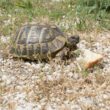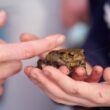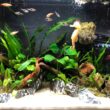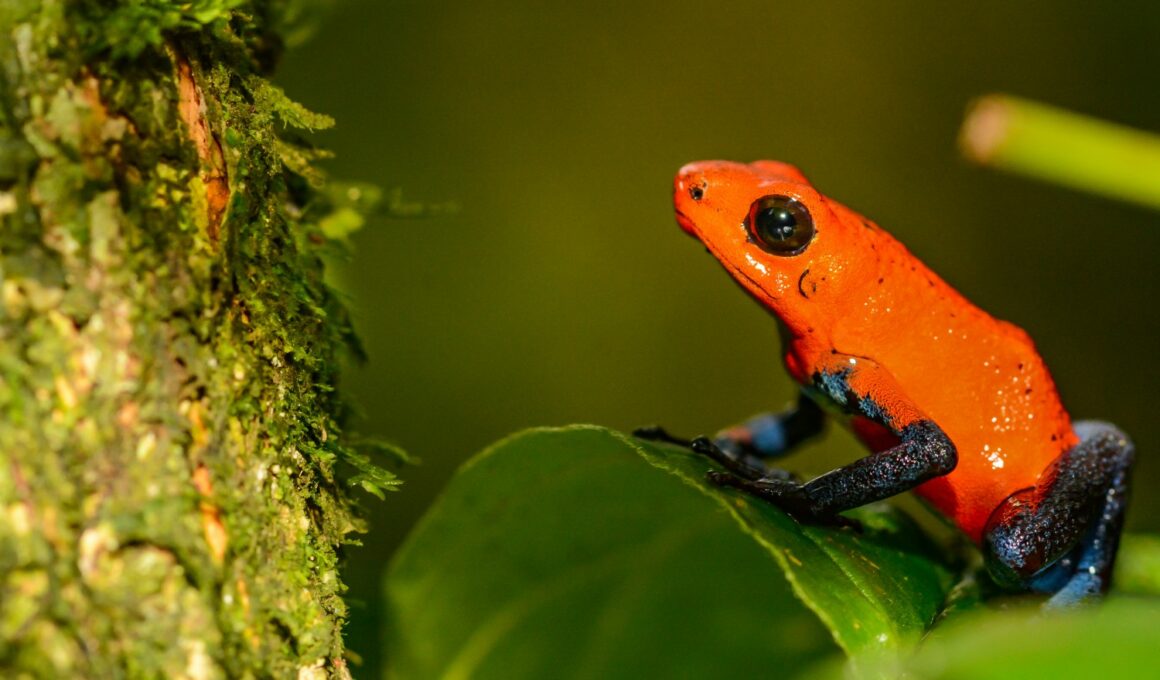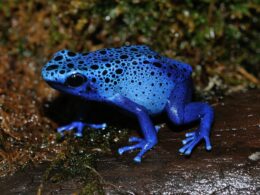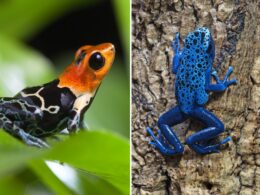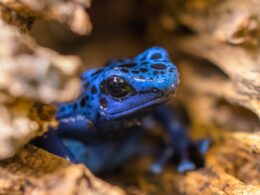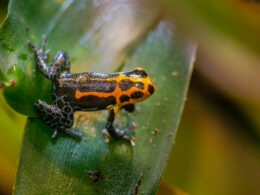In this article Show
If you are a pet lover with a penchant for diving deep into the intriguing world of reptiles and amphibians—then you’re in for a treat. Today, we’ll be delving into the captivating universe of the Strawberry Poison Dart Frog, or Dendrobates pumilio if we’re getting all scientific.
Now, while I might spend my weekends geeking out over reptile forums and books (no shame in that!), I understand that not everyone might be as well-versed. So, I’m here to break it down, keep it clear, and ensure you walk away with a newfound appreciation for this little gem of nature.
Why is the Strawberry Poison Dart Frog so unique, you ask? Well, apart from its vibrant attire, this tiny creature holds a myriad of surprises beneath its colorful exterior. From its intriguing history in the rainforests to its unparalleled defense mechanisms, there’s so much more than meets the eye.
So, whether you’re a budding herpetologist, a pet enthusiast, or just someone with a thirst for knowledge, come join me on this journey. Together, we’ll explore the ins and outs of the Strawberry Poison Dart Frog and uncover the reasons behind its allure.
History and Evolution
Diving back in time, the Strawberry Poison Dart Frog has an origin story as colorful as its skin. Its scientific name, Dendrobates pumilio, hints at its ties to a family of equally fascinating creatures. But let’s unravel this story step by step.
Origin and Distribution of Dendrobates Pumilio
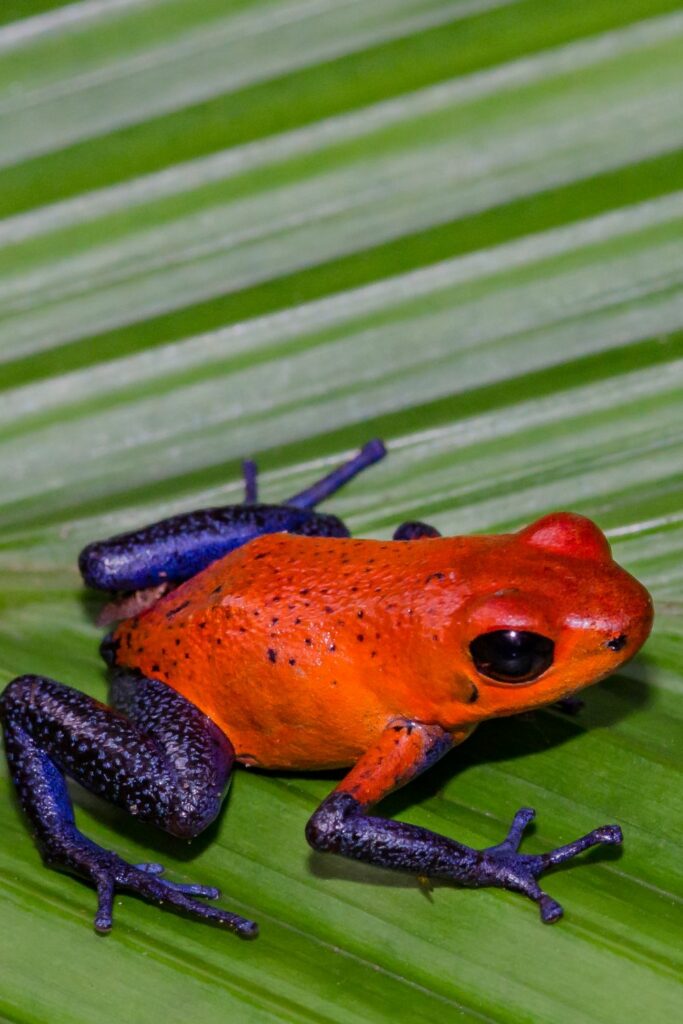
The Dendrobates pumilio primarily hails from the humid lowlands of Central America, specifically spanning countries like Costa Rica, Nicaragua, and parts of Panama. These regions have the perfect mix of tropical climate, dense vegetation, and balanced ecosystems that the frog thrives in.
Over the years, this distribution may have shifted slightly due to various factors, but the heart of their habitat remains in these Central American pockets.
What’s interesting to note is that within these territories, the color and pattern variations of the Strawberry Poison Dart Frog can differ significantly.
From vibrant reds and blues to striking oranges, the frog’s appearance often changes based on its specific location—a phenomenon known as regional morphs. It’s almost like nature’s way of keeping us on our toes!
Evolutionary Significance in the Rainforest Ecosystem
So, why does this tiny frog hold such an important evolutionary spot in the vast rainforest biome? To start with, its vibrant coloration isn’t just for show. It’s a result of aposematism, a visual warning system that signifies to potential predators: “I’m toxic, and eating me won’t end well for you!”
By evolving this distinct and recognizable coloration, the Dendrobates pumilio stands out amidst the dense rainforest foliage, sending a clear signal to its would-be attackers.
This adaptation not only benefits the frog by warding off potential threats but also helps predators avoid consuming a toxic meal. It’s a win-win!
Furthermore, their unique feeding habits play a role in controlling insect populations within their habitat. By feeding on specific ants and termites, these frogs contribute to the balance of the rainforest’s intricate food web. Without them, we might see a very different dynamic in these lush forests.
Physical Characteristics
When it comes to nature’s artistry, the Strawberry Poison Dart Frog stands as a true masterpiece. Its intricate design and vibrant palette are more than just a feast for the eyes; they serve a deep-rooted purpose in the frog’s survival.
Let’s dive into the specifics of this amphibian’s aesthetics and its evolutionary advantages.
Description of Color, Size, and Distinguishing Features
Size-wise, the Dendrobates pumilio is a diminutive wonder, typically measuring between 0.75 to 1.5 inches in length. It might be small, but what it lacks in size, it more than compensates for its striking appearance.
As mentioned earlier, this frog’s coloration can vary significantly based on its location. However, the most common hue is a bright, eye-catching red or orange, often contrasted with blue or black legs—a true testament to nature’s vivid imagination.
The body, sleek and smooth, is adorned with unique patterns that distinguish individual morphs from different regions. Some might showcase dotted patterns, while others might flaunt more intricate stripes or bands.
Role of Vibrant Colors in Survival: Aposematism
While these colors and patterns certainly make the Strawberry Poison Dart Frog a photographer’s dream, they serve a much more critical purpose: survival.
This phenomenon is termed ‘aposematism’, a biological strategy where animals develop bright colorations or patterns as a warning sign to potential predators. Essentially, it’s nature’s version of a “Do Not Eat” label.
For the Dendrobates pumilio, this aposematic coloration signifies that they are toxic and can be harmful if ingested. This serves a dual purpose. For the frog, it’s a deterrent that keeps many predators at bay.
For potential predators, it’s a visual cue that prevents them from consuming something that could be detrimental to their health. Over time, many predators in the frog’s ecosystem have learned to associate bright colors with danger, ensuring the safety of our vibrant amphibian.
Habitat and Distribution
The magic of the Strawberry Poison Dart Frog doesn’t end with its captivating colors; its habitat and distribution are equally fascinating. These frogs have carved out niches in some of the most vibrant and biodiverse ecosystems on our planet. Let’s journey through the tropical terrains they call home.
Regions Where They Are Commonly Found
The heartland of the Dendrobates pumilio is the lush, tropical rainforests of Central America. To be more precise, they can be predominantly found in the humid lowlands of countries like Costa Rica, Nicaragua, and Panama.
Within these nations, their presence is not uniform; certain regions or microhabitats, often untouched by urbanization, house denser populations of these frogs.
Venturing into these rainforests, it’s not uncommon for explorers or nature enthusiasts to chance upon these tiny, vivid creatures hopping about the forest floor or climbing low vegetation. In fact, they’ve become a sort of symbol for the rich biodiversity of Central American rainforests.
Preferred Environmental Conditions: Temperature, Humidity, Terrain
The Dendrobates pumilio has specific environmental preferences that allow it to thrive:
Temperature
Being ectothermic (or cold-blooded), these frogs rely on external heat sources. The optimal temperature range for them lies between 72°F and 80°F (22°C to 27°C). The warm, tropical climate of Central American rainforests provides a consistent temperature range, which is vital for their daily activities and metabolic processes.
Humidity
High humidity levels are crucial for the well-being of the Strawberry Poison Dart Frog. They prefer environments with around 80-100% relative humidity. This high moisture content helps in keeping their skin moist, essential for their respiration and overall health.
Terrain
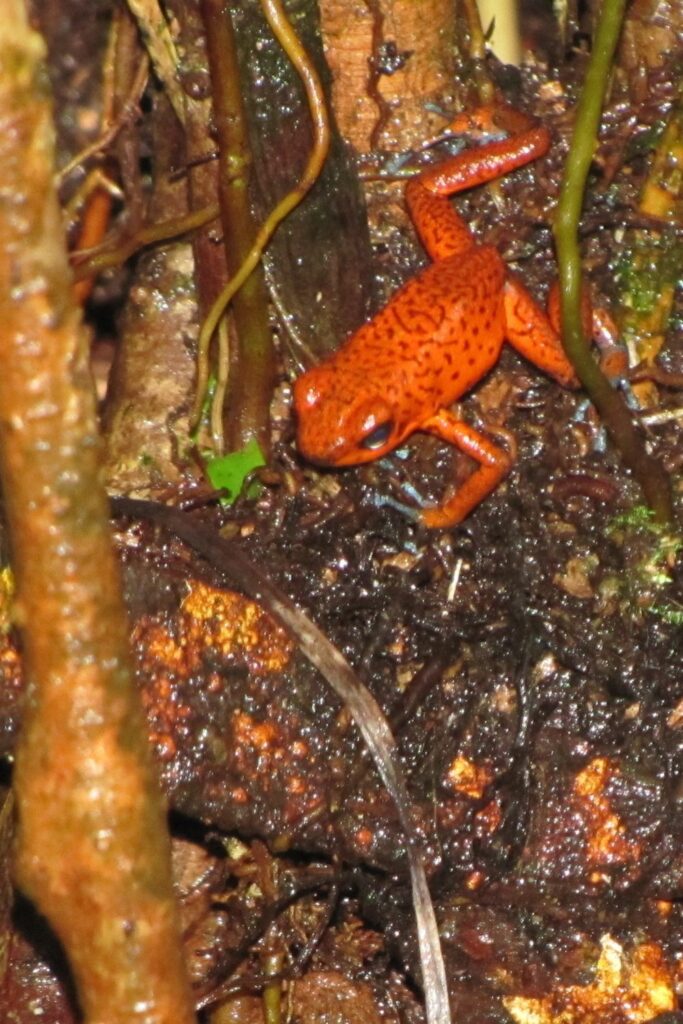
The terrain preference of the Dendrobates pumilio is quite specific. They favor leaf litter on the rainforest floor, fallen logs, and low-lying plants. These terrains offer them shelter, hunting grounds, and breeding sites. Moreover, these areas often have small, temporary water bodies like puddles, which are vital for their reproduction.
In Essence🐸
The Strawberry Poison Dart Frog is a testament to the beauty and balance of Central American rainforests. Every aspect of its habitat, from the temperature to the terrain, plays a role in its survival and day-to-day life. Understanding these intricate relationships not only deepens our appreciation for the frog but also highlights the importance of conserving these delicate ecosystems.
Diet and Predation
Ah, the circle of life! The Strawberry Poison Dart Frog might be tiny, but it’s an active participant in the complex web of the rainforest food chain. From what it eats to what might try to eat, let’s delve into the dietary habits and defensive strategies of this remarkable amphibian.
Primary Food Sources and Hunting Techniques
The Dendrobates pumilio has a palate that leans heavily towards small invertebrates. Its primary food sources are:
- Ants: Particularly those from the genera Brachymyrmex and Paratrechina. Interestingly, it’s believed that certain ants play a significant role in the frog’s toxicity. By consuming these ants, the frog assimilates specific alkaloids that contribute to its poisonous nature.
- Termites: Another favorite on the menu, termites offer a protein-packed meal that’s easy to hunt.
- Mites and other tiny arthropods: These round up the variety in their diet, ensuring they get a mix of nutrients.
As for hunting techniques, the Dendrobates pumilio is a sit-and-wait predator. Using its keen senses, it patiently waits for prey to come within striking distance. Once it spots a potential meal, the frog makes a swift move, capturing the prey with its sticky tongue. This strategy minimizes energy expenditure while maximizing hunting success.
Predators and the Frog’s Defense Mechanisms
Being small and brightly colored, the Strawberry Poison Dart Frog might seem like an easy target, but nature has equipped it with some impressive defense mechanisms.
Toxicity
As previously discussed, this frog is toxic—a defense mechanism evolved over millions of years. When a predator tries to eat the frog, the toxins can cause paralysis or even death. Over time, many potential predators have learned to associate the frog’s bright coloration with danger, a phenomenon termed aposematism.
Camouflage
Despite its vibrant colors, the frog’s specific hues and patterns can help it blend into the colorful rainforest floor, especially amidst fallen fruits and flowers.
Behavioral Adaptations
When threatened, the frog may adopt a defensive posture, puffing up its body and standing its ground. This display, combined with its colors, serves as a final warning to would-be predators.
While these defenses are effective against many predators, some, like the snake Leimadophis epinephelus, have evolved a resistance to the frog’s toxins and can safely consume them.
In the grand theatre of the rainforest, the Strawberry Poison Dart Frog plays a pivotal role. It’s a predator, a prey, and a brilliant example of nature’s intricate balance of survival and adaptation.
Reproduction and Lifespan
The life cycle of the Strawberry Poison Dart Frog is a riveting tale of love, growth, and survival. From its unique courtship dances to its journey from a tiny egg to a vibrant adult, there’s much to marvel at. Let’s explore the intricacies of its reproduction and lifespan.
Mating Rituals and Breeding Season
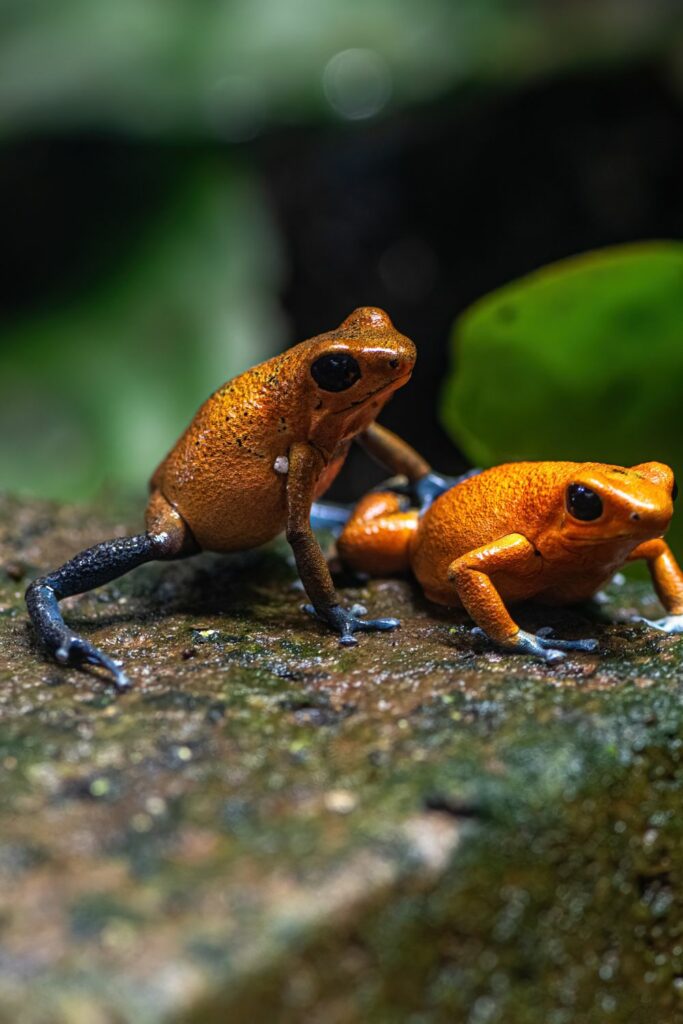
The Dendrobate Pumilio’s quest for love is both enthralling and strategic:
Calling
Males start the courting process with a series of calls, using specialized vocal sacs. These calls not only attract potential female mates but also serve as a warning to other males, marking their territory.
Dance of Persuasion
Once a female approaches, the male puts on a display, hopping around her in a sort of dance to further entice her.
Breeding Sites
If the female is impressed, she follows the male to a suitable breeding site, often a damp, sheltered spot. This could be under leaf litter, inside bromeliads, or other suitable locations.
Egg Laying
After mating, the female lays a clutch of eggs, usually ranging between 3 to 5. The male then guards these eggs, ensuring they remain moist and safe from predators.
Development From Egg to Tadpole to Adult Frog
Egg Stage
This phase lasts for about 10-14 days. The male’s role is crucial here, as he keeps the eggs hydrated by transporting water using his back.
Tadpole Stage
Once the eggs hatch, an even more fascinating behavior emerges. The mother transports each tadpole, one by one, on her back to individual water-filled locations, often inside bromeliads.
Here, the tadpoles will develop for the next 6-8 weeks. To nourish them, the female lays unfertilized eggs in each tadpole’s water source, providing them with essential nutrients.
Metamorphosis
After the tadpole stage, these young ones undergo metamorphosis, transforming into tiny, colorful froglets, ready to start their terrestrial life.
Average Lifespan in the Wild vs. Captivity
In the wild, the Strawberry Poison Dart Frog faces numerous challenges, from predators to environmental hazards. Despite these odds, they have a relatively good lifespan, averaging around 3 to 4 years. Their survival instincts, combined with their toxicity, play a role in this longevity.
In captivity, with threats minimized and a consistent food source, their lifespan can be extended. It’s not uncommon for these frogs to live up to 6-8 years in a controlled environment, provided they receive proper care, nutrition, and habitat conditions.
From the dance of courtship to the vigilant care for their young, the Strawberry Poison Dart Frog showcases nature’s intricate choreography of reproduction and survival. Their journey, from a guarded egg to a lively adult, embodies the beauty and challenges of life in the rainforest.
Toxicity and Defense Mechanisms
Ah, the mystique of the Strawberry Poison Dart Frog deepens when we delve into its toxic nature. This seemingly delicate creature packs a punch that has both intrigued and warned many. Let’s explore the roots of its toxicity, its historical significance, and the fascinating link between its diet and potency.
Source of Their Potent Toxin
The primary toxin found in the Dendrobates pumilio is batrachotoxin, a potent neurotoxin that affects the nervous system of those unlucky enough to ingest or come into contact with it. But where does this frog source such a formidable weapon?
Surprisingly, it’s believed the frog doesn’t produce the toxin itself. Instead, it accumulates and modifies it from its diet, particularly from certain ants and possibly other small arthropods that it consumes.
These creatures contain precursors to the toxin, which, when ingested by the frog, undergo a transformation, resulting in the powerful batrachotoxin.
Use by Indigenous Communities for Hunting
The name “dart frog” isn’t merely for flair; it stems from indigenous communities’ utilization of the frog’s toxin. Historically, certain tribes, primarily in South America, learned of the frog’s toxic nature and ingeniously used it to their advantage.
By applying the toxin to their blow darts’ tips, hunters could swiftly and effectively paralyze or kill their prey, making hunting in the dense forest a tad bit easier.
It’s noteworthy, however, that while the term “dart frog” is applied broadly to the family, not all species, including our strawberry variety, were used for this purpose.
How The Frog’s Diet Can Influence Its Toxicity
The connection between the Dendrobates pumilio’s diet and its toxicity is one of nature’s fascinating feedback loops. As mentioned, the frog derives its toxins from certain ants and arthropods. If the frog’s diet lacks these specific prey items, its toxicity diminishes.
This phenomenon has been observed in captivity. When Strawberry Poison Dart Frogs are fed a controlled diet without the toxin-laden ants, over time, they lose their toxic properties. This discovery has deepened our understanding of the symbiotic relationship between diet, defense, and the environment.
Conservation Status
Amidst the splendor and wonder of the Strawberry Poison Dart Frog, there lies a pressing narrative: the story of its conservation. While nature has equipped this frog with vibrant warnings and potent toxins for survival, human-induced challenges loom large.
Let’s shed light on its conservation status, the challenges it faces, and the collective efforts to secure its future.
Threats Facing the Strawberry Poison Dart Frog
Habitat Loss
The primary threat facing the Dendrobates pumilio is the destruction of its habitat. With increasing deforestation, urbanization, and land conversion for agriculture, the rainforests they call home are shrinking.
Pollution
Chemical runoff from agricultural practices can contaminate the freshwater sources the frogs rely on for reproduction. Pesticides can disrupt their food chain, and pollutants can directly harm the frogs.
Climate Change
As with many species, the changing climate poses unpredictable challenges. Altered rainfall patterns, temperature shifts, and increasing droughts can affect their habitat quality and availability.
Illegal Pet Trade
Their striking appearance makes them desirable in the pet trade. While many are bred in captivity for this purpose, illegal collection from the wild still persists, putting added pressure on wild populations.
Conservation Efforts and Protected Regions
Protected Areas
Several regions within Central America, especially Costa Rica and Panama, have designated national parks and reserves that protect the habitat of the Strawberry Poison Dart Frog. Areas like the Bocas del Toro in Panama and the Corcovado National Park in Costa Rica serve as sanctuaries.
Awareness and Education
Local and international organizations are working to raise awareness about the importance of conserving these frogs and their habitats. Educational programs, eco-tourism, and community involvement play pivotal roles.
Legislation
Many countries have imposed regulations on the collection and export of wild-caught specimens to combat the illegal pet trade.
Role of Zoos and Breeding Programs
Zoos and herpetological societies around the world play a significant role in the conservation of the Strawberry Poison Dart Frog:
Captive Breeding
Many zoos have established successful breeding programs, ensuring a stable population in captivity. This not only reduces the demand for wild-caught frogs but also serves as a potential reservoir for reintroduction efforts.
Research
Zoos and academic institutions collaborate to study the frog’s biology, behavior, and needs, driving informed conservation strategies.
Education
Zoos serve as platforms for public education, teaching visitors about the frog’s ecological importance and the threats they face, fostering a culture of conservation.
In the grand tapestry of our planet’s biodiversity, the Strawberry Poison Dart Frog is a vivid thread. Ensuring its survival requires a collective effort, understanding, and a commitment to preserving the intricate balance of its ecosystem. Every step taken towards its conservation resonates as a pledge to protect the myriad wonders of our natural world.
Frequently Asked Questions
The world of the Strawberry Poison Dart Frog is fascinating, but with fascination often comes a flurry of questions and some misconceptions. Let’s tackle some frequently asked questions and shed light on the myths surrounding this vibrant amphibian.
Are Strawberry Poison Dart Frogs really poisonous?
Yes, they are. In the wild, these frogs accumulate toxins from their diet, particularly from specific ants, which makes them toxic to potential predators. However, when they are raised in captivity and fed a diet without these ants, they tend to lose their toxicity over time.
Can I keep a Strawberry Poison Dart Frog as a pet?
It’s possible, but with conditions. These frogs are popular in the pet trade due to their striking appearance. However, one should always ensure they are purchasing from reputable breeders who raise the frogs in captivity, rather than supporting the illegal collection from the wild. Proper care, diet, and habitat conditions are also essential for their well-being.
Why are they called “Dart Frogs”?
The name “dart frog” comes from indigenous tribes’ historical practice of using the frog’s toxin on the tips of blow darts for hunting. However, not all species of dart frogs were used for this purpose.
Do they only come in red?
No, they don’t! While red or strawberry-colored morphs are common, the Strawberry Poison Dart Frog exhibits a range of colors based on their geographical location, from blues and oranges to greens.
Are they endangered?
While they are not currently listed as endangered, the Dendrobates pumilio does face threats, especially habitat loss. Conservation efforts are ongoing to protect their natural habitats.
Can they be touched?
It’s best to avoid handling them. While the toxins can be harmful if ingested or if they enter the bloodstream, merely touching a wild frog is unlikely to harm a human. Still, handling can be stressful for the frog and could remove protective mucus from their skin.
Do they croak or make sounds?
Yes, they do! Males are known to produce calls, especially during the mating season, to attract females and warn other males of their territory.
Is it true that their color is a warning to predators?
Absolutely. Their vibrant coloration is a classic example of aposematism, a biological strategy where creatures use warning colors to signal potential danger (their toxicity) to predators.
Conclusion
The Strawberry Poison Dart Frog, with its vibrant colors and intriguing behaviors, serves as a vivid reminder of nature’s wonders. From its unique survival tactics to its role in the ecosystem, this tiny creature teaches us about adaptation, balance, and the importance of conservation.
As we continue to learn and marvel at its existence, it underscores the broader narrative of cherishing and protecting our planet’s biodiversity.

